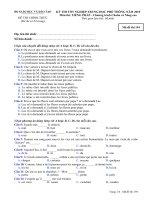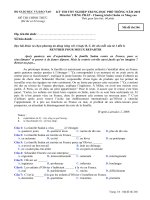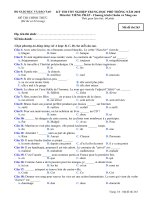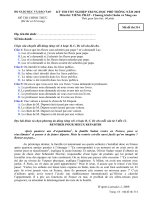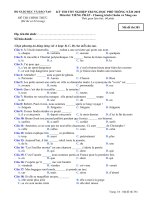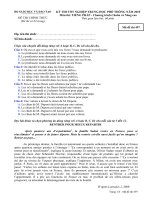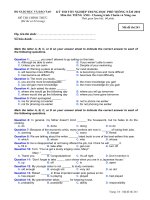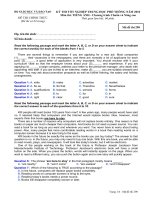New SAT Math workbook
Bạn đang xem bản rút gọn của tài liệu. Xem và tải ngay bản đầy đủ của tài liệu tại đây (1.83 MB, 354 trang )
BOXMATH.VN
Petersons.com/publishing
Check out our Web site at www.petersons.com/publishing to see if there is any new information
regarding the test and any revisions or corrections to the content of this book. We’ve made sure the
information in this book is accurate and up-to-date; however, the test format or content may have
changed since the time of publication.
BOXMATH.VN
BOXMATH.VN
About Thomson Peterson’s
Thomson Peterson’s (www.petersons.com) is a leading provider of education information and
advice, with books and online resources focusing on education search, test preparation, and financial
aid. Its Web site offers searchable databases and interactive tools for contacting educational institu-
tions, online practice tests and instruction, and planning tools for securing financial aid. Peterson’s
serves 110 million education consumers annually.
For more information, contact Peterson’s, 2000 Lenox Drive, Lawrenceville, NJ 08648; 800-338-
3282; or find us on the World Wide Web at www.petersons.com/about.
® 2005 Thomson Peterson’s, a part of The Thomson Corporation
Thomson Learning
TM
is a trademark used herein under license.
Editor: Wallie Walker Hammond; Production Editor: Alysha Bullock;
Manufacturing Manager: Judy Coleman; Composition Manager: Melissa Ignatowski;
Cover Design: Greg Wuttke
ALL RIGHTS RESERVED. No part of this work covered by the copyright herein may be repro-
duced or used in any form or by any means—graphic, electronic, or mechanical, including photo-
copying, recording, taping, Web distribution, or information storage and retrieval systems—without
the prior written permission of the publisher.
For permission to use material from this text or product, submit a request online at
www.thomsonrights.com
Any additional questions about permissions can be submitted by email to
ISBN: 0-7689-1717-4
Printed in the United States of America
10 9 8 7 6 5 4 3 2 07 06 05
BOXMATH.VN
v
Contents
About the SAT vii
1. Operations with Whole Numbers and Decimals 1
Diagnostic Test • Addition of Whole Numbers • Subtraction of Whole Numbers •
Multiplication of Whole Numbers • Division of Whole Numbers • Addition or
Subtraction of Decimals • Multiplication of Decimals • Division of Decimals • The
Laws of Arithmetic • Estimating Answers • Retest • Solutions to Practice Exercises
2. Operations with Fractions 19
Diagnostic Test • Addition and Subtraction • Multiplication and Division • Simplifying
Fractions • Operations with Mixed Numbers • Comparing Fractions • Retest • Solutions
to Practice Exercises
3. Verbal Problems Involving Fractions 39
Diagnostic Test • Part of a Whole • Finding Fractions of Fractions • Finding Whole
Numbers • Solving with Letters • Retest • Solutions to Practice Exercises
4. Variation 53
Diagnostic Test • Ratio and Proportion • Direct Variation • Inverse Variation • Retest •
Solutions to Practice Exercises
5. Percent 69
Diagnostic Test • Fractional and Decimal Equivalents of Percents • Finding a Percent of
a Number • Finding a Number When a Percent Is Given • To Find What Percent One
Number Is of Another • Percents Greater Than 100 • Retest • Solutions to Practice
Exercises
6. Verbal Problems Involving Percent 85
Diagnostic Test • Percent of Increase or Decrease • Discount • Commission • Profit and
Loss • Taxes • Retest • Solutions to Practice Exercises
7. Averages 103
Diagnostic Test • Simple Average • To Find a Missing Number When an Average Is
Given • Weighted Average • Retest • Solutions to Practice Exercises
8. Concepts of Algebra—Signed Numbers and Equations 115
Diagnostic Test • Signed Numbers • Solution of Linear Equations • Simultaneous
Equations in Two Unknowns • Quadratic Equations • Equations Containing Radicals •
Retest • Solutions to Practice Exercises
9. Literal Expressions 133
Diagnostic Test • Communication with Letters • Retest • Solutions to Practice Exercises
BOXMATH.VN
Contents
vi
www.petersons.com
10. Roots and Radicals 143
Diagnostic Test • Addition and Subtraction of Radicals • Multiplication and Division of
Radicals • Simplifying Radicals Containing a Sum or Difference • Finding the Square
Root of a Number • Retest • Solutions to Practice Exercises
11. Factoring and Algebraic Fractions 155
Diagnostic Test • Simplifying Fractions • Addition or Subtraction of Fractions •
Multiplication or Division of Fractions • Complex Algebraic Fractions • Using
Factoring to Find Missing Values • Retest • Solutions to Practice Exercises
12. Problem Solving in Algebra 171
Diagnostic Test • Coin Problems • Consecutive Integer Problems • Age Problems •
Investment Problems • Fraction Problems • Mixture Problems • Motion Problems •
Work Problems • Retest • Solutions to Practice Exercises
13. Geometry 197
Diagnostic Test • Areas • Perimeter • Right Triangles • Coordinate Geometry • Parallel
Lines • Triangles • Polygons • Circles • Volumes • Similar Polygons • Retest • Solutions
to Practice Exercises
14. Inequalities 231
Diagnostic Test • Algebraic Inequalities • Geometric Inequalities • Retest • Solutions to
Practice Exercises
15. Numbers and Operations, Algebra, and Fractions 243
16. Additional Geometry Topics, Data Analysis, and Probability 273
Practice Test A 313
Practice Test B 319
Practice Test C 327
Solutions to Practice Tests 333
BOXMATH.VN
vii
About the SAT
PURPOSE OF THE SAT
The SAT is a standardized exam used by many colleges and universities in the
United States and Canada to help them make their admissions decisions. The test
is developed and administered by Educational Testing Service (ETS) for the Col-
lege Entrance Examination Board.
The SAT consists of two different types of exams designated SAT and SAT II.
The SAT tests verbal and mathematical reasoning skills — your ability to under-
stand what you read, to use language effectively, to reason clearly, and to apply
fundamental mathematical principles to unfamiliar problems. SAT II tests mastery
of specific subjects such as Chemistry or French or World History.
TAKING THE SAT
The SAT is offered on one Saturday morning in October, November, December,
January, March, May, and June. When you apply to a college, find out whether it
requires you to take the SAT and if so when scores are due. To make sure your
scores arrive in time, sign up for a test date that’s at least six weeks before the
school’s deadline for test scores.
Registration forms for the SAT are available in most high school guidance of-
fices. You can also get registration forms and any other SAT information from:
College Board SAT Program
P.O. Box 6200
Princeton, NJ 08541-6200
609-771-7600
Monday through Friday, 8:30 a.m. to 9:30 p.m. Eastern Time
www.collegeboard.com
Along with your registration form you will receive a current SAT Student Bulletin.
The bulletin includes all necessary information on procedures, exceptions and spe-
cial arrangements, times and places, and fees.
BOXMATH.VN
About the SAT
viii
www.petersons.com
FORMAT OF THE NEW SAT
The new SAT is a three-hour, mostly multiple-choice examination divided into
sections as shown in the chart below. One of the sections is experimental. Your
score on the six nonexperimental sections is the score colleges use to evaluate your
application.
The critical reading sections of the SAT use Sentence Completions to measure
your knowledge of the meanings of words and your understanding of how parts of
sentences go together, and Critical Reading questions (short and long passages) to
measure your ability to read and think carefully about the information presented in
passages.
The mathematical sections use Standard Multiple-Choice Math, Quantitative
Comparisons, and Student-Produced Response Questions to test your knowledge
of arithmetic, algebra, and geometry. Many of the formulas that you need will be
given in the test instructions. You are not required to memorize them. SAT math
questions are designed to test your skill in applying basic math principles you
already know to unfamiliar situations.
The experimental section of SAT may test critical reading or mathematical rea-
soning, and it can occur at any point during the test. This section is used solely
by the testmakers to try out questions for use in future tests. You won’t know which
section it is. So you’ll have to do your best on all of the sections.
FORMAT OF A TYPICAL SAT
Number of
Section #/Content Questions Time
(1) Writing 1 essay 25 min.
(2) Mathematics 20 25 min.
Standard Multiple Choice
(3)* “Wild Card” an Experimental Section varies 30 min.
(Varies with test)
(4) Critical Reading 16 25 min.
Sentence Completions 8
(5) Writing 35 25 min.
Standard Multiple Choice
(6) Mathematics 25 min.
Standard Multiple-choice 8
Grid-Ins 10
(7) Critical Reading 19 25 min.
Sentence Completions 5
(8) Mathematics 20 min.
Standard Multiple Choice 16
(9) Critical Reading 13 20 min.
Sentence Completions 6
* Can occur in any section
BOXMATH.VN
About the SAT
ix
www.petersons.com
THE NEW SAT MATH QUESTIONS
The mathematical reasoning sections of the SAT test problem solving in numbers
and operations, algebra I and II, geometry, statistics, probability, and data analysis
using two question types:
• Standard multiple-choice questions give you a problem in arithmetic,
algebra, or geometry. Then you choose the correct answer from the five
choices.
• Grid-Ins do not give you answer choices. You have to compute the answer
and then use the ovals on the answer sheet to fill in your solution.
Although calculators are not required to answer any SAT math questions, students
are encouraged to bring a calculator to the test and to use it wherever it is helpful.
Mathematics tests your knowledge of arithmetic, algebra, and geometry. You
are to select the correct solution to the problem from the five choices given.
Example:
If (x + y)
2
= 17, and xy = 3, then x
2
+ y
2
=
(A) 11
(B) 14
(C) 17
(D) 20
(E) 23
Solution:
The correct answer is (A).
(x
+ y)
2
= 17
(x
+ y)(x
+ y) = 17
x
2
+ 2xy + y
2
= 17
Since xy = 3,
x
2
+ 2(3) + y
2
= 17
x
2
+ 6 + y
2
= 17
x
2
+ y
2
= 11
Student-Produced Responses test your ability to solve mathematical problems when
no choices are offered.
Example:
On a map having a scale of
1
4
inch = 20 miles, how many inches should
there be between towns that are 70 miles apart?
Solution:
The correct answer is
7
8
or .875, depending upon whether you choose
to solve the problem using fractions or decimals.
BOXMATH.VN
About the SAT
x
www.petersons.com
Using fractions Using decimals
1
4
20 70
20
70
4
70
4
1
20
7
8
=
=
=
=
x
x
x
.
.
.
25
20 70
20 17 5
875
=
=
=
x
x
x
HOW TO USE THE ANSWER GRID
The answer grid for student-produced response (grid-ins) questions is similar to
the grid used for your zip code on the personal information section of your answer
sheet. An example of the answer grid is shown below.
The open spaces above the grid are for you to write in the numerical value of your
answer. The first row of ovals has only two ovals in the middle with a “/”. These
allow you to enter numbers in fractional form. Since a fraction must have both a
numerator and a denominator, it is not possible that the leftmost or rightmost posi-
tions could have a “/”. To protect you from yourself, there are no “/s” in those
positions. The next row has decimal points. The horizontal bar separates the frac-
tion lines and decimal points from the digits 0 to 9. Record your answers to grid-in
questions according to the rules that follow.
GRID RULES
1. Write your answer in the boxes at the top of the grid.
Technically this isn’t required by the SAT. Realistically, it gives you something
to follow as you fill in the ovals. Do it—it will help you.
2. Mark the bubbles that correspond to the answer you entered in the boxes.
Mark one bubble per column. The machine that scores the test can only read the
bubbles, so if you don’t fill them in, you won’t get credit. Just entering your
answer in the boxes is not enough.
BOXMATH.VN
About the SAT
xi
www.petersons.com
3. Start your answer in any column, if space permits.
Unused columns should be left blank. Don’t put in zeroes. Look at this
example:
Here are two ways to enter an answer of “150.”
4. Work with decimals or fractions.
An answer can be expressed as
3
4
or as .75. Do not put a zero in front of a
decimal that is less than 1. Just remember that you have only four spaces to work
with and that a decimal point or a fraction slash uses up one of the spaces.
For decimal answers, be as accurate as possible but keep within the four spaces.
Say you get an answer of .1777. Here are your options:
Fractions do not have to be simplified to simplest form unless they don’t fit in
the answer grid. For example, you can grid
4
10
, but you can’t grid
12
16
because
you’d need five spaces. So, you would simplify it and grid
3
4
.
BOXMATH.VN
About the SAT
xii
www.petersons.com
5. Express a mixed number as a decimal or as an improper fraction.
If you tried to grid 1
3
4
, it would be read as
13
4
, which would give you a wrong
answer. Instead you should grid this answer as 1.75 or as
7
4
.
6. If more than one answer is possible, grid any one.
Sometimes the problems in this section will have more than one correct answer.
In such cases, choose one answer and grid it. For example, if a question asks
for a prime number between 5 and 13, the answer could be 7 or 11. Grid 7 or
grid 11, but don’t put in both answers.
BOXMATH.VN
About the SAT
xiii
www.petersons.com
CALCULATORS AND THE SAT
Calculators are allowed on the SAT. You may bring to your exam any of the fol-
lowing types of calculators:
• four-function
• scientific
•graphing
You may not bring calculators of the following types:
• calculators with paper tape or printers
• laptop computers
• telephones with calculators
• “hand-held” microcomputers
Make sure that the calculator you bring is one you are thoroughly familiar with.
WHEN TO USE A CALCULATOR
No question requires the use of a calculator. For some questions a calculator may
be helpful; for others it may be inappropriate. In general, the calculator may be
useful for any question that involves arithmetic computations. Remember, though,
that the calculator is only a tool. It can help you avoid inaccuracies in computation,
but it cannot take the place of understanding how to set up and solve a mathemati-
cal problem.
Here is a sample problem for which a calculator would be useful:
Example:
The cost of two dozen apples is $3.60. At this rate, what is the cost of 10
apples?
(A) $1.75
(B) $1.60
(C) $1.55
(D) $1.50
(E) $1.25
Solution:
The correct answer is (D).
Make a ratio of apples to dollars:
apples
dollars
:
.
$.
24
360
10
24 36
36
24
150
=
=
==
x
x
x
A calculator would be useful in solving this problem. Although the calculations
are fairly simple, the calculator can improve your speed and accuracy.
BOXMATH.VN
About the SAT
xiv
www.petersons.com
Here is a problem for which a calculator would not be useful:
Example:
Joshua travels a distance of d miles in t - 6 hours. At this rate, how many
miles will he travel in t
2
- 36 hours?
(A) d(t + 6)
(B) d(t - 6)
(C)
d
t + 6
(D)
d
t − 6
(E)
t
d
+ 6
Solution:
The correct answer is (A).
rate =
distance
time
Joshua's rate =
d
t − 6
To calculate his new distance, use distance = rate × time
Distance =
d
t
t
d
t
t
−
−
=
−
+
6
36
6
6
2
()
())( )
()
t
dt
−
=+
6
6
This is an algebra problem. Using a calculator would not be helpful.
SCORING THE SAT
Every correct answer is worth one point. If you leave an answer blank, you score
no point. For incorrect answers to all verbal questions and to regular mathematics
questions, you lose one-fourth of a point. For incorrect answers to quantitative
comparisons, you lose one-third of a point. For incorrect answers to student-pro-
duced responses, there is no penalty. The penalties for wrong answers are intended
to discourage random guessing.
Regardless of the number of questions on the test, all SAT scores are reported
on a scale of 200 to 800. The scores are based on the nonexperimental sections and
are broken down into separate math and verbal scores.
Five or six weeks after the exam, your scores will be sent to the colleges you
have named on your registration form, to your high school, and to you.
BOXMATH.VN
About the SAT
xv
www.petersons.com
HOW TO USE THIS BOOK
The math review that follows is designed as a self-teaching text to help you pre-
pare for the mathematics sections of the SAT. At the beginning of each chapter,
you will find a ten-question diagnostic test. Try this test before you read the chap-
ter. Check your answers with the solutions provided at the end of the chapter. If
you get eight to ten questions right, you may skip that chapter and go right on to
the next diagnostic test at the beginning of the following chapter. Or you may
prefer to skim the instructional material anyway, just for review, but not bother
with the practice exercises. If you get five to seven questions right, you might do
the practice exercises only in the sections dealing with problems you missed. If
you get fewer than five questions right, you should work carefully through the
entire chapter.
At the end of each chapter you will find a retest that is similar to the diagnostic
test. After working through the chapter, you should do better on the retest. If not,
go back and review any instructional material dealing with errors you made before
proceeding to the next chapter.
Working diligently through each chapter in this manner will strengthen your
weaknesses and prepare you to get your best score on the three Practice new SAT
Math Tests at the end of this book—and on your actual SAT.
Good luck.
BOXMATH.VN
BOXMATH.VN
1
1
Operations with Whole
Numbers and Decimals
DIAGNOSTIC TEST
Directions: Work out each problem. Circle the letter that appears before
your answer.
Answers are at the end of the chapter.
1. Find the sum of 683, 72, and 5429.
(A) 5184
(B) 6184
(C) 6183
(D) 6193
(E) 6284
2. Subtract 417 from 804.
(A) 287
(B) 388
(C) 397
(D) 387
(E) 288
3. Find the product of 307 and 46.
(A) 3070
(B) 14,082
(C) 13,922
(D) 13,882
(E) 14,122
4. Divide 38,304 by 48.
(A) 787
(B) 798
(C) 824
(D) 1098
(E) 1253
5. Add 6.43 + 46.3 + .346.
(A) 14.52
(B) 53.779
(C) 53.392
(D) 53.076
(E) 1452
6. Subtract 81.763 from 145.1.
(A) 64.347
(B) 64.463
(C) 63.463
(D) 63.337
(E) 63.347
7. Multiply 3.47 by 2.3.
(A) 79.81
(B) 7.981
(C) 6.981
(D) 7.273
(E) 7.984
8. Divide 2.163 by .03.
(A) 7210
(B) 721
(C) 72.1
(D) 7.21
(E) 0.721
9. Find 3 - 16 ÷ 8 + 4 × 2.
(A) 9
(B) 2
1
3
(C) 10
(D) 18
(E)
2
3
10. Which of the following is closest to
8317 91
217 8
×
×.
?
(A) 4
(B) 40
(C) 400
(D) 4000
(E) 40,000
BOXMATH.VN
Chapter 1
2
www.petersons.com
In preparing for the mathematics section of your college entrance examination, it is most important to overcome
any fear of mathematics. The level of this examination extends no further than relatively simple geometry. Most
problems can be solved using only arithmetic. By reading this chapter carefully, following the sample problems,
and then working on the practice problems in each section, you can review important concepts and vocabulary, as
well as familiarize yourself with various types of questions. Since arithmetic is basic to any further work in
mathematics, this chapter is extremely important and should not be treated lightly. By doing these problems
carefully and reading the worked-out solutions, you can build the confidence needed to do well.
1. ADDITION OF WHOLE NUMBERS
In the process of addition, the numbers to be added are called addends. The answer is called the sum. In writing
an addition problem, put one number underneath the other, being careful to keep columns straight with the units’
digits one below the other. If you find a sum by adding from top to bottom, you can check it by adding from
bottom to top.
Example:
Find the sum of 403, 37, 8314, and 5.
Solution:
403
37
8314
+5
8759
Exercise 1
1. Find the sum of 360, 4352, 87, and 205.
(A) 5013
(B) 5004
(C) 5003
(D) 6004
(E) 6013
2. Find the sum of 4321, 2143, 1234, and 3412.
(A) 12,110
(B) 11,011
(C) 11,101
(D) 11,111
(E) 11,110
3. Add 56 + 321 + 8 + 42.
(A) 427
(B) 437
(C) 517
(D) 417
(E) 527
4. Add 99 + 88 + 77 + 66 + 55.
(A) 384
(B) 485
(C) 385
(D) 375
(E) 376
5. Add 1212 + 2323 + 3434 + 4545 + 5656.
(A) 17,171
(B) 17,170
(C) 17,160
(D) 17,280
(E) 17,270
BOXMATH.VN
Operations with Whole Numbers and Decimals
3
www.petersons.com
2. SUBTRACTION OF WHOLE NUMBERS
The number from which we subtract is called the minuend. The number which we take away is called the subtra-
hend. The answer in subtraction is called the difference.
If 5 is subtracted from 11, the minuend is 11, the subtrahend is 5, and the difference is 6.
Since we cannot subtract a larger number from a smaller one, we often must borrow in performing a subtrac-
tion. Remember that when we borrow, because of our base 10 number system, we reduce the digit to the left by
1, but increase the right-hand digit by 10.
Example:
54
–38
Since we cannot subtract 8 from 4, we borrow 1 from 5 and change the 4 to 14. We are really borrowing 1 from
the tens column and, therefore, add 10 to the ones column. Then we can subtract.
Solution:
4
1
4
– 3 8
16
Sometimes we must borrow across several columns.
Example:
503
– 267
We cannot subtract 7 from 3 and cannot borrow from 0. Therefore we reduce the 5 by one and make the 0 into a
10. Then we can borrow 1 from the 10, making it a 9. This makes the 3 into 13.
Solution:
4
1
03 49
1
3
– 2 6 7 – 2 6 7
23 6
Exercise 2
1. Subtract 803 from 952.
(A) 248
(B) 148
(C) 249
(D) 149
(E) 147
2. From the sum of 837 and 415, subtract 1035.
(A) 217
(B) 216
(C) 326
(D) 227
(E) 226
3. From 1872 subtract the sum of 76 and 43.
(A) 1754
(B) 1838
(C) 1753
(D) 1839
(E) 1905
4. Find the difference between 732 and 237.
(A) 496
(B) 495
(C) 486
(D) 405
(E) 497
5. By how much does the sum of 612 and 315
exceed the sum of 451 and 283?
(A) 294
(B) 1661
(C) 293
(D) 197
(E) 193
BOXMATH.VN
Chapter 1
4
www.petersons.com
3. MULTIPLICATION OF WHOLE NUMBERS
The answer to a multiplication problem is called the product. The numbers being multiplied are called factors of
the product.
When multiplying by a number containing two or more digits, place value is extremely important when
writing partial products. When we multiply 537 by 72, for example, we multiply first by 2 and then by 7. How-
ever, when we multiply by 7, we are really multiplying by 70 and therefore leave a 0 at the extreme right before
we proceed with the multiplication.
Example:
537
× 72
1074
+ 37590
38664
If we multiply by a three-digit number, we leave one zero on the right when multiplying by the tens digit and two
zeros on the right when multiplying by the hundreds digit.
Example:
372
× 461
372
22320
+ 148800
171492
Exercise 3
Find the following products.
1. 526 multiplied by 317
(A) 156,742
(B) 165,742
(C) 166,742
(D) 166,748
(E) 166,708
2. 8347 multiplied by 62
(A) 517,514
(B) 517,414
(C) 517,504
(D) 517,114
(E) 617,114
3. 705 multiplied by 89
(A) 11,985
(B) 52,745
(C) 62,705
(D) 62,745
(E) 15,121
4. 437 multiplied by 607
(A) 265,259
(B) 265,219
(C) 265,359
(D) 265,059
(E) 262,059
5. 798 multiplied by 450
(A) 358,600
(B) 359,100
(C) 71,820
(D) 358,100
(E) 360,820
BOXMATH.VN
Operations with Whole Numbers and Decimals
5
www.petersons.com
1. Divide 391 by 23.
(A) 170
(B) 16
(C) 17
(D) 18
(E) 180
2. Divide 49,523,436 by 9.
(A) 5,502,605
(B) 5,502,514
(C) 5,502,604
(D) 5,502,614
(E) 5,502,603
4. DIVISION OF WHOLE NUMBERS
The number being divided is called the dividend. The number we are dividing by is called the divisor. The answer
to the division is called the quotient. When we divide 18 by 6, 18 is the dividend, 6 is the divisor, and 3 is the
quotient. If the quotient is not an integer, we have a remainder. The remainder when 20 is divided by 6 is 2,
because 6 will divide 18 evenly, leaving a remainder of 2. The quotient in this case is 6
2
6
. Remember that in
writing the fractional part of a quotient involving a remainder, the remainder becomes the numerator and the
divisor the denominator.
When dividing by a single-digit divisor, no long division procedures are needed. Simply carry the remainder
of each step over to the next digit and continue.
Example:
)
658
9724
4
34 4
12
Exercise 4
3. Find the remainder when 4832 is divided by 15.
(A) 1
(B) 2
(C) 3
(D) 4
(E) 5
4. Divide 42,098 by 7.
(A) 6014
(B) 6015
(C) 6019
(D) 6011
(E) 6010
5. Which of the following is the quotient of
333,180 and 617?
(A) 541
(B) 542
(C) 549
(D) 540
(E) 545
BOXMATH.VN
Chapter 1
6
www.petersons.com
5. ADDITION OR SUBTRACTION OF DECIMALS
The most important thing to watch for in adding or subtracting decimals is to keep all decimal points underneath
one another. The proper placement of the decimal point in the answer will be in line with all the decimal points
above.
Example:
Find the sum of 8.4, .37, and 2.641
Solution:
8.4
.37
+ 2.641
11.411
Example:
From 48.3 subtract 27.56
Solution:
48 30
7121
.
– 2 7 . 5 6
20.74
In subtraction, the upper decimal must have as many decimal places as the lower, so we must fill in zeros where
needed.
Exercise 5
1. From the sum of .65, 4.2, 17.63, and 8, subtract
12.7.
(A) 9.78
(B) 17.68
(C) 17.78
(D) 17.79
(E) 18.78
2. Find the sum of .837, .12, 52.3, and .354.
(A) 53.503
(B) 53.611
(C) 53.601
(D) 54.601
(E) 54.611
3. From 561.8 subtract 34.75.
(A) 537.05
(B) 537.15
(C) 527.15
(D) 527.04
(E) 527.05
4. From 53.72 subtract the sum of 4.81 and 17.5.
(A) 31.86
(B) 31.41
(C) 41.03
(D) 66.41
(E) 41.86
5. Find the difference between 100 and 52.18.
(A) 37.82
(B) 47.18
(C) 47.92
(D) 47.82
(E) 37.92
BOXMATH.VN
Operations with Whole Numbers and Decimals
7
www.petersons.com
6. MULTIPLICATION OF DECIMALS
In multiplying decimals, we proceed as we do with integers, using the decimal points only as an indication of
where to place a decimal point in the product. The number of decimal places in the product is equal to the sum of
the number of decimal places in the numbers being multiplied.
Example:
Multiply .375 by .42
Solution:
.375
× .42
750
+ 15000
.15750
Since the first number being multiplied contains three decimal places and the second number contains two deci-
mal places, the product will contain five decimal places.
To multiply a decimal by 10, 100, 1000, etc., we need only to move the decimal point to the right the proper
number of places. In multiplying by 10, move one place to the right (10 has one zero), by 100 move two places to
the right (100 has two zeros), by 1000 move three places to the right (1000 has three zeros), and so forth.
Example:
The product of .837 and 100 is 83.7
Exercise 6
Find the following products.
1. 437 × .24 =
(A) 1.0488
(B) 10.488
(C) 104.88
(D) 1048.8
(E) 10,488
2. 5.06 × .7 =
(A) .3542
(B) .392
(C) 3.92
(D) 3.542
(E) 35.42
3. 83 × 1.5 =
(A) 12.45
(B) 49.8
(C) 498
(D) 124.5
(E) 1.245
4. .7314 × 100 =
(A) .007314
(B) .07314
(C) 7.314
(D) 73.14
(E) 731.4
5. .0008 × 4.3 =
(A) .000344
(B) .00344
(C) .0344
(D) 0.344
(E) 3.44
BOXMATH.VN
Chapter 1
8
www.petersons.com
7. DIVISION OF DECIMALS
When dividing by a decimal, always change the decimal to a whole number by moving the decimal point to the
end of the divisor. Count the number of places you have moved the decimal point and move the dividend’s
decimal point the same number of places. The decimal point in the quotient will be directly above the one in the
dividend.
Example:
Divide 2.592 by .06
Solution:
)
.
06 2 592
43 2
To divide a decimal by 10, 100, 1000, etc., we move the decimal point the proper number of places to the left. The
number of places to be moved is always equal to the number of zeros in the divisor.
Example:
Divide 43.7 by 1000
Solution:
The decimal point must be moved three places (there are three zeros in 1000) to the left. Therefore,
our quotient is .0437
Sometimes division can be done in fraction form. Always remember to move the decimal point to the end of the
divisor (denominator) and then the same number of places in the dividend (numerator).
Example:
Divide:
.
.
.
.
0175
05
175
5
35==
Exercise 7
1. Divide 4.3 by 100.
(A) .0043
(B) 0.043
(C) 0.43
(D) 43
(E) 430
2. Find the quotient when 4.371 is divided by .3.
(A) 0.1457
(B) 1.457
(C) 14.57
(D) 145.7
(E) 1457
3. Divide .64 by .4.
(A) .0016
(B) 0.016
(C) 0.16
(D) 1.6
(E) 16
4. Find .12 ÷
2
5.
.
(A) 4.8
(B) 48
(C) .03
(D) 0.3
(E) 3
5. Find
10 2
03
.
.
÷
17
1
.
.
.
(A) .02
(B) 0.2
(C) 2
(D) 20
(E) 200
BOXMATH.VN
Operations with Whole Numbers and Decimals
9
www.petersons.com
8. THE LAWS OF ARITHMETIC
Addition and multiplication are commutative operations, as the order in which we add or multiply does not
change an answer.
Example:
4+7=7+4
5•3=3•5
Subtraction and division are not commutative, as changing the order does change the answer.
Example:
5–3≠ 3–5
20 ÷ 5 ≠ 5 ÷ 20
Addition and multiplication are associative, as we may group in any manner and arrive at the same answer.
Example:
(3 + 4) + 5 = 3 + (4 + 5)
(3 • 4) • 5 = 3 • (4 • 5)
Subtraction and division are not associative, as regrouping changes an answer.
Example:
(5 – 4) – 3 ≠ 5 – (4 – 3)
(100 ÷ 20) ÷ 5 ≠ 100 ÷ (20 ÷ 5)
Multiplication is distributive over addition. If a sum is to be multiplied by a number, we may multiply each
addend by the given number and add the results. This will give the same answer as if we had added first and then
multiplied.
Example:
3(5 + 2 + 4) is either 15 + 6 + 12 or 3(11).
The identity for addition is 0 since any number plus 0, or 0 plus any number, is equal to the given number.
The identity for multiplication is 1 since any number times 1, or 1 times any number, is equal to the given
number.
There are no identity elements for subtraction or division. Although 5 – 0 = 5, 0 – 5 ≠ 5. Although 8 ÷ 1 = 8,
1 ÷ 8 ≠ 8.
When several operations are involved in a single problem, parentheses are usually included to make the order of
operations clear. If there are no parentheses, multiplication and division are always performed prior to addition and
subtraction.
Example:
Find 5 • 4 + 6 ÷ 2 – 16 ÷ 4
Solution:
The + and – signs indicate where groupings should begin and end. If we were to insert parentheses
to clarify operations, we would have (5 · 4) + (6 ÷ 2) – (16 ÷ 4), giving 20 + 3 – 4 = 19.
BOXMATH.VN

